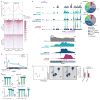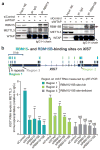m(6)A RNA methylation promotes XIST-mediated transcriptional repression
- PMID: 27602518
- PMCID: PMC5509218
- DOI: 10.1038/nature19342
m(6)A RNA methylation promotes XIST-mediated transcriptional repression
Abstract
The long non-coding RNA X-inactive specific transcript (XIST) mediates the transcriptional silencing of genes on the X chromosome. Here we show that, in human cells, XIST is highly methylated with at least 78 N6-methyladenosine (m6A) residues-a reversible base modification of unknown function in long non-coding RNAs. We show that m6A formation in XIST, as well as in cellular mRNAs, is mediated by RNA-binding motif protein 15 (RBM15) and its paralogue RBM15B, which bind the m6A-methylation complex and recruit it to specific sites in RNA. This results in the methylation of adenosine nucleotides in adjacent m6A consensus motifs. Furthermore, we show that knockdown of RBM15 and RBM15B, or knockdown of methyltransferase like 3 (METTL3), an m6A methyltransferase, impairs XIST-mediated gene silencing. A systematic comparison of m6A-binding proteins shows that YTH domain containing 1 (YTHDC1) preferentially recognizes m6A residues on XIST and is required for XIST function. Additionally, artificial tethering of YTHDC1 to XIST rescues XIST-mediated silencing upon loss of m6A. These data reveal a pathway of m6A formation and recognition required for XIST-mediated transcriptional repression.
Conflict of interest statement
The authors declare no competing financial interests.
Figures















Comment in
-
Functional Dissection of the m6A RNA Modification.Trends Biochem Sci. 2017 Feb;42(2):85-86. doi: 10.1016/j.tibs.2016.12.004. Epub 2017 Jan 4. Trends Biochem Sci. 2017. PMID: 28063638 Free PMC article. No abstract available.
-
The rise of epitranscriptomic era: implications for cardiovascular disease.Cardiovasc Res. 2017 Apr 1;113(5):e2-e3. doi: 10.1093/cvr/cvx030. Cardiovasc Res. 2017. PMID: 28384367 No abstract available.
References
-
- Penny GD, Kay GF, Sheardown SA, Rastan S, Brockdorff N. Requirement for Xist in X-chromosome inactivation. Nature. 1996;379:131–137. - PubMed
-
- Wutz A. Gene silencing in X-chromosome inactivation: advances in understanding facultative heterochromatin formation. Nat Rev Genet. 2011;12:542–553. - PubMed
MeSH terms
Substances
Grants and funding
LinkOut - more resources
Full Text Sources
Other Literature Sources
Molecular Biology Databases
Research Materials

